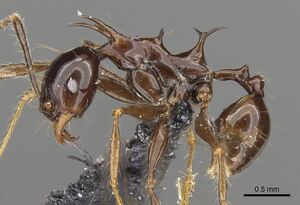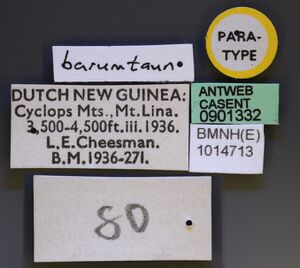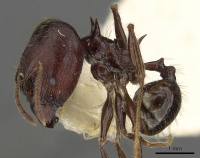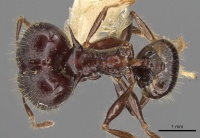Pheidole barumtaun
| Pheidole barumtaun | |
|---|---|

| |
| Scientific classification | |
| Kingdom: | Animalia |
| Phylum: | Arthropoda |
| Class: | Insecta |
| Order: | Hymenoptera |
| Family: | Formicidae |
| Subfamily: | Myrmicinae |
| Tribe: | Attini |
| Genus: | Pheidole |
| Species: | P. barumtaun |
| Binomial name | |
| Pheidole barumtaun Donisthorpe, 1938 | |
Among the examined material, workers were collected from the following microhabitats of primary montane forest: under loose bark of log, in and under living bark of recently felled tree, crown of Pandanus, decayed stalk in Pandanus, in leaf litter. Several of these microhabitats suggest the species might nest and forage in vegetation. (Sarnat et al. 2016)
Identification
Sarnat et al. (2016) - The major workers of Pheidole barumtaun are separated from those of Pheidole drogon by the fine carinulae that cover the posterolateral lobes. They are separated from Pheidole viserion by the less sculptured gastral tergite, less striate mandibles and more arcuate carinulae of the frons. Both major and minor workers of P. barumtaun are separated from P. viserion by head and gaster color, which are dark brown in the former and clear yellow in the latter. The minor workers are separated from those of P. drogon by the narrower head (CI 84–90 vs. 89–91), longer legs (FL 1.22–1.38 mm vs. 1.07–1.16 mm) and relatively longer antennal scapes (SI 146–165 vs. 135–141).
There are, however, some distinct differences between the type series (Cyclops Mts.) and material collected by Snelling from the Wapoga River Area. The type series workers, both majors and minors, are distinctly tricolored with dark brown heads and gasters that contrast with a yellowish mesosoma. The Wapoga workers are uniformly dark reddish brown. The type series majors also have downcurved propodeal spines, versus upturned in the Wapago material. However, there are not clear morphometric differences between these populations, and until further evidence is gathered we consider the variation to be infraspecific.
Keys including this Species
Distribution
Latitudinal Distribution Pattern
Latitudinal Range: -3.14° to -3.14°.
| North Temperate |
North Subtropical |
Tropical | South Subtropical |
South Temperate |
- Source: AntMaps
Distribution based on Regional Taxon Lists
Indo-Australian Region: New Guinea (type locality).
Distribution based on AntMaps
Distribution based on AntWeb specimens
Check data from AntWeb
Countries Occupied
| Number of countries occupied by this species based on AntWiki Regional Taxon Lists. In general, fewer countries occupied indicates a narrower range, while more countries indicates a more widespread species. |

|
Estimated Abundance
| Relative abundance based on number of AntMaps records per species (this species within the purple bar). Fewer records (to the left) indicates a less abundant/encountered species while more records (to the right) indicates more abundant/encountered species. |

|
Biology
Castes
Worker
minor
Images from AntWeb
  
| |
| Paratype of Pheidole barumtaun. Worker. Specimen code casent0901332. Photographer Ryan Perry, uploaded by California Academy of Sciences. | Owned by NHMUK, London, UK. |
Nomenclature
The following information is derived from Barry Bolton's Online Catalogue of the Ants of the World.
- barumtaun. Pheidole (Pheidolacanthinus) barumtaun Donisthorpe, 1938a: 141, figs. 1, 2 (s.w.m.) NEW GUINEA.
Unless otherwise noted the text for the remainder of this section is reported from the publication that includes the original description.
Description
Worker
Sarnat et al. (2016) - Major HW 2.10–2.25, HL 2.10–2.22, SL 1.10–1.19, FL 1.62–1.78, EL 0.19–0.24, PSL1 0.61–0.74, PSL3 0.66–0.74, PeL 0.59–0.74, PeW 0.17–0.18, PpW 0.52–0.67, CI 99–105, SI 52–55 (n = 5). Uniformly reddish brown or tricolored with head and gaster reddish brown, mesosoma shining yellowish brown. Head square; posterior margin describing a broad and shallow ‘V’. Head strongly convex in lateral view without any impression of the vertex. Posterolateral lobes separated by a deep median impression giving them a strongly convex appearance. Antennal scrobe absent. Antennal scapes long with erect hairs; strongly curved basally to conform to convexity of head. Frontal carina indistinct; blending with parallel carinulae an undistinguished by strength or length. Anterior medial clypeal margin weakly emarginated. Mandible bidentate apically; striations limited to posterolateral portion. Hypostomal bridge with broad, distinct median tooth; submedian teeth of subequal length to median tooth. Clypeus with strong median carina. All dorsal surfaces of head covered by very fine, parallel, nonintersecting carinulae. Spaces between carinulae weakly foveolate. Carinulae arcuate from anterior clypeal border to frons, converging towards median impression of posterolateral lobes. Carinulae of posterolateral lobes distinctly transverse. Corners of posterolateral lobes shining, but covered with very fine carinulae or striae. Mesosoma armed with long strongly produced pronotal spines, mesonotal spines and propodeal spines. Pronotal spines of subequal length as propodeal spines; directed anterolaterally and becoming downcurved apically. Mesonotal spines approximately eye-length, strongly upturned. Propodeal spines relatively straight, directed posterolaterally. Mesosoma mostly smooth and shining with some transverse striae on dorsum. Petiole relatively long, approximately equal in length to propodeal spine. Petiolar node cuneiform with weakly emarginate vertex. Postpetiole approximately equal in height to petiole; in dorsal view strongly transverse with small lateral projections and weakly sculptured. Basal third of first gastral tergite shagreened.
Minor HW 0.69–0.80, HL 0.80–0.90, SL 1.02–1.18, FL 1.22–1.38, EL 0.15–0.16, ML 1.13–1.28, PSL1 0.53–0.66, PSL2 0.44–0.57, PSL3 0.47–0.62, PeL 0.35–0.45, PeW 0.07–0.13, PpW 0.18–0.23, CI 84–90, SI 146–165 (n = 8). Strongly shining, uniformly reddish brown or tricolored with head and gaster reddish brown, mesosoma shining yellowish brown. Head elongate ovoid, strongly tapering behind the eyes to a narrow posterior margin. Nuchal carinae thin but distinct and forming collar around posterodorsal head margin. Antennal scapes with erect hairs, distinctly surpassing posterior head margin. Head completely smooth except for a few arcuate carinulae between the eyes and mandible. Mesosoma with extremely long spines on the pronotum and propodeum, and shorter spines on the mesonotum. Pronotal spines approximately same length as tibiae; directed anterolaterally and becoming downcurved apically. Mesonotal spines approximately eye-length; spinose to weakly lamellate and flattened; directed posterolaterally and straight. Propodeal spines fused basally into thick upright trunk before diverging; strongly bifurcate, directed posterolaterally and becoming downcurved apically. Petiole very elongate. Petiolar node conical.
Type Material
Sarnat et al. (2016) - New Guinea [Papua, Jayapura], Cyclops Mountains, Mount Lina, nest in rotten wood, 1070–1370 m, 1936–03 (L.E. Cheesman) The Natural History Museum, 3 syntype majors and 2 syntype minors examined.
Etymology
Sarnat et al. (2016) - Pheidole barumtaun was named by Donisthorpe after Barumtaun camp where Cheesman made her collection.
References
- Donisthorpe, H. 1938a. Five new species of ant, chiefly from New Guinea. Ann. Mag. Nat. Hist. 11(1): 140-148 (page 141, figs. 1, 2, soldier, worker, male described)
- Sarnat E. M., Fischer, G. and E.P. Economo. 2016. Inordinate spinescence: taxonomic revision and microtomography of the Pheidole cervicornis species group (Hymenoptera, Formicidae). PLoS ONE. 11:e0156709. doi:10.1371/journal.pone.0156709
References based on Global Ant Biodiversity Informatics
- Donisthorpe H. 1938. Five new species of ant, chiefly from New Guinea. Annals and Magazine of Natural History (11)1: 140-148.
- Donisthorpe H. 1947. Pheidole (Pheidolacanthinus) striatus sp. n. from New Guinea, with notes on the subgenus Pheidolacanthinus F. Smith (Hym., Formicidae). Entomologist's Monthly Magazine 83:172-174.
- Janda M., G. D. Alpert, M. L. Borowiec, E. P. Economo, P. Klimes, E. Sarnat, and S. O. Shattuck. 2011. Cheklist of ants described and recorded from New Guinea and associated islands. Available on http://www.newguineants.org/. Accessed on 24th Feb. 2011.
- Sarnat E. M., G. Fischer, and E. P. Economo. 2016. Inordinate spinescence: taxonomic revision and microtomography of the Pheidole cervicornis species group (Hymenoptera, Formicidae). PLoS ONE 11(7): e0156709. doi:10.1371/journal.pone.0156709

